Post by Fadril Adren on Oct 26, 2016 20:33:07 GMT -5

"Everything that has transpired has done so according to my design. Your friends up there on the Sanctuary Moon are walking into a trap. As is your Rebel fleet! It was I who allowed the Alliance to know the location of the shield generator."
–Emperor Palpatine
In less than two years, Star Wars™: Armada has already established itself as a heavyweight in the miniatures genre. Its massive capital ships batter each other with powerful lasers, missiles, and torpedoes. They deploy squadrons of starfighters to launch bombing runs or intercept enemy fighters. They lumber across the battlefield with tremendous momentum, forcing you to account for your movement and your strategy multiple turns in advance with the game's custom maneuver tool and command dials.
The game of large, tactical fleet battles in the Star Wars universe, Armada assigns you the role of fleet admiral and demands that you consider the shape of your engagement long before the first shots are fired.
Soon, the game's rich strategic and tactical options are going to explode further outward with the campaign rules from The Corellian Conflict. Announced in July, just prior to Gen Con, The Corellian Conflict features a map of the Corellian sector, new squadron cards for your existing squadrons, and all the rules and resources that you need to win the Corellian sector for either the Empire or the Rebel Alliance.
If Armada was already the game for clever admirals (and fans of huge ships blasting each other square in the hull), then The Corellian Conflict magnifies much of what is best about the game, largely transforming it from a game of tactical fleet battles to a game of strategic space warfare.
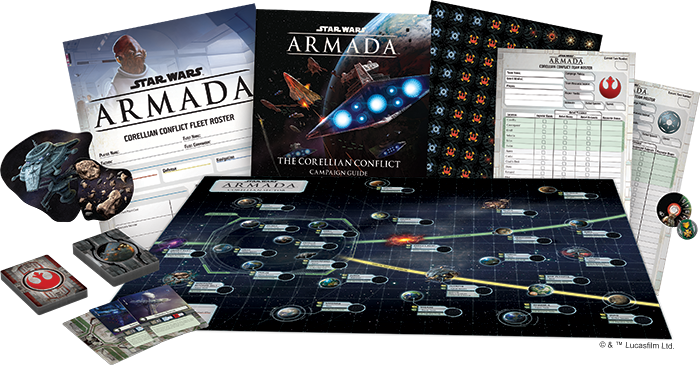
Plan Your Conquest
To the standard rounds and shape of your Armada games, The Corellian Conflict adds structures for campaign turns that add new layers of strategic decisions to each of your battles. Teams plan their assaults in the Strategy Phase, engage the enemy in the Battle Phase, and reap their rewards (or suffer their losses) in the Management Phase.
Strategy Phase
In the Strategy Phase, you and your teammates review the map of the Corellian sector and plan your next move. Starting with the Rebel team, or the team with the fewest campaign points, each team can declare one assault, designating a player to lead the strike force and targeting a specific location on the map. Then, the other team must choose a player to defend against the assault before they can declare their own assault and force you to assign a defender.
Normally, winning one of these assaults as the attacker means that during the Management Phase you'll be able to eliminate any base or outpost your opponents may have had at the location. You'll also gain campaign points equal to the location's Victory Bonus Value.
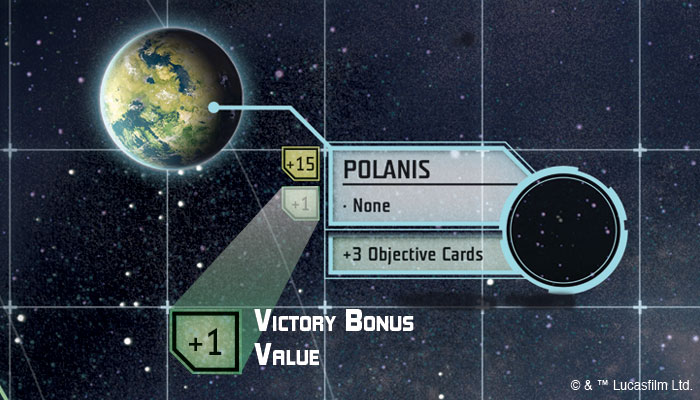
Since you need to amass campaign points in order to win The Corellian Conflict, those locations with higher Victory Bonus Values will always be tempting, but there's far more to consider than just the immediate reward.
For starters, if your opponents successfully defend against an assault where they have a base or outpost, they gain a campaign point. This means you cannot afford to launch assaults against your opponents' bases that you don't think you can win.
Additionally, especially in the early turns, you might want to focus on building toward the later stages of your campaign. Whenever you win an assault, you can choose to spend resources to construct a new base or outpost at the location. Then, in subsequent turns, that location will generate resources for you and may even generate other strategic effects. Amassing these resources over the course of several turns may eventually put you in a better position to win the campaign points you need than vying for them on less favorable terms.

Another way during the Strategy Phase that you might set yourself up for later success is to launch a "Special Assault." Once per campaign turn, your team may declare that one of your assaults is a Special Assault, and it's then fought according to one of the campaign's two faction-specific objectives:
* The Rebel Alliance may launch a Hyperlane Raid .
* The Imperial Navy may proceed with a Show of Force .


These Special Assaults can only be declared in certain locations, and both change the stakes of your battle. Instead of vying for campaign points, you're battling for a quick boost of resources. Even if you lose a Special Assault, you're guaranteed to gain resources whenever you declare one, and these resources have serious repercussions in the Management Phase.
So you might want to declare a Special Assault to gain quick resources. Maybe the better long-term plan is to establish a base. Maybe you would rather keep your main fleet focused on assaulting the locations with the highest Victory Bonus Values. Either way, you'll need to keep an eye to the long-term throughout the Strategy Phase, because The Corellian Conflict aligns perfectly with your standard Armada battles by making you plan your conquest of the Corellia system multiple turns in advance.

Battle Phase
After the teams have declared their assaults and assigned their fleets, they resolve the engagements in the Battle Phase. These play out like your standard Armada battles except that the player who declared the assault always has the initiative, and many of your battles will use the new campaign-specific objectives.

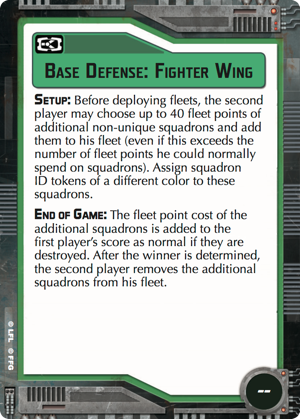
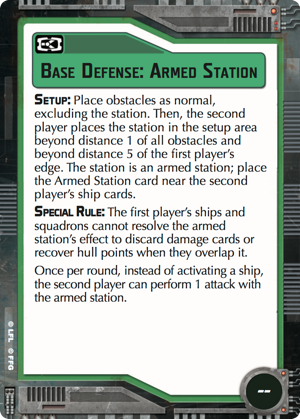
* If your assault is a Special Assault, it will use the corresponding objective, either Hyperlane Raid or Show of Force.
* If you declare an assault against a Rebel or Imperial base, you'll play according the defender's selection from three new base defense objectives— Ion Cannon, Fighter Wing, or Armed Station.
* Finally, if you declare an assault that is not a Special Assault and is not directed against your opponents' base, the defender may still have the option of using a campaign-specific objective, provided it is listed by the contested location.
Management Phase
It is in the Management Phase that you reap the rewards of your efforts in the Strategy and Battle Phases—or suffer the consequences.
In addition to tracking the results of your battles and accruing campaign points, you can also spend any of the resources you have gained over the campaign. You might use these resources to establish a base or an outpost in the location where you just won a battle. You might use them to refit the ships and squadrons in your fleet. Or you might use them to expand your fleet.

After winning a battle at Truuzdann, the Imperial team spends fifteen resources to construct a base and secure the planet's eight resources, aiming to build for the future.
Establishing a base or outpost at a location secures its resources, giving you access to them on each subsequent turn that you hold the base. Additionally, many locations come with strategic effects like Repair Yards, Diplomats, or Skilled Spacers.
* Repair Yards improve your ability to refit your fleet.
* Diplomats allow you to mark certain unoccupied regions as "off-limits" for a campaign turn.
* And if you're the second player, Skilled Spacers allow you to temporarily swap one of your objectives for another objective of the same category before your opponent chooses from the options.
Naturally, the longer you hold a base or outpost, the more valuable it is to your effort, but the question is always whether or not the resources you devote early in the campaign toward establishing that settlement would have carried you further toward victory if you spent them on expanding or refitting your fleet.
It's hard to say that there's any better way to spend your resources than to refit your fleet. After all, your fleet is the currency by which you play the game. You can't win battles or take control of locations within the sector if you don't have ships to fly. Throughout your battles in The Corellian Conflict, your ships and squadrons may become "scarred," and refitting them is the only way to remove those scars.
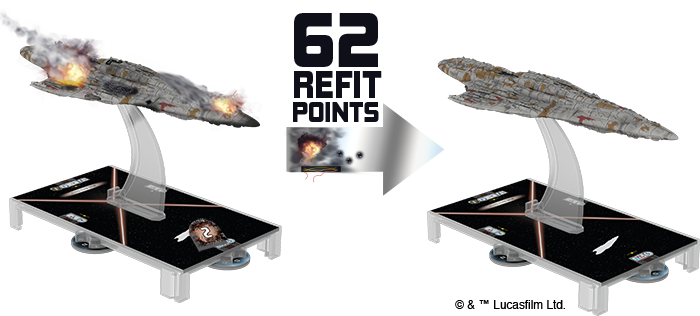
Ships and squadrons become scarred if they're destroyed in battle. A scarred ship is then marked by a scar token and must discard one of its defense tokens before the start of a battle. Likewise, a scarred squadron must suffer one damage before the battle begins. If a scarred ship or squadron is destroyed in battle, it is then eliminated from its controller's fleet, along with any upgrades that were on it, and those cards may not be purchased again.
This is particularly notable given the fact that all the game's unique cards are unique to an entire team, not just within a single fleet. This means, if one of your teammates is running Darth Vader as her commander, you cannot run Darth Vader at the head of his elite TIE Advanced Squadron. And just as unique cards are unique to the team, they are unique in time; if Darth Vader's squadron shoots down a scarred Jan Ors, Jan Ors is removed from the campaign entirely, never to return.
For this reason, you may even consider targeting powerful ships like the Demolisher just to remove them, prioritizing them even higher than the battle itself. Boba Fett, Major Rhymer, the Mon Karren, the Interdictor, Han Solo, and Grand Moff Tarkin's flagship—they may all find hefty prices on their heads. And if they're removed, you'll need to adapt your fleet and your strategy to accommodate for their absence.

Before such ships are removed, however, you have the opportunity to repair them by spending refit points and resources equal to half its fleet point cost, rounded up. Refitting your fleet is so important that you gain thirty refit points each campaign turn that you can spend before you need to dip into your resources. And each of your Repair Yards adds an additional five refit points to your total.
Of course, if you don't need to spend your resources just to maintain your fleet, you may be able to spend those resources to expand it by adding new ships or squadrons—to a maximum of 500 total fleet points.
Whethr you're refitting your fleet, expanding it, or tracking permanent damage, you track all your changes on your fleet roster at the end of the Management Phase. Then you're ready to begin the next campaign turn.

Who Will Claim the Corellian Sector?
For all its massive starships and sleek starfighter squadrons, Star Wars: Armada is primarily a game of tactics and stratagems. To win, you must factor in both your ability to survive your battles and to complete your battle objectives. You try to outmaneuver your foe not within a single move, but many moves in advance. And soon, with The Corellian Conflict, you'll be able to plot moves within moves, aiming them all toward something greater than you've yet experienced in Armada.
This isn't just a game of tactical space battles, anymore. This is a full-scale war for the Corellian sector!


